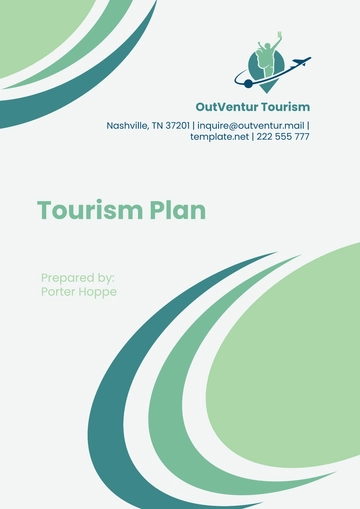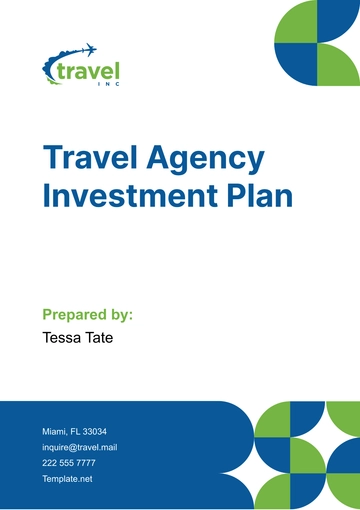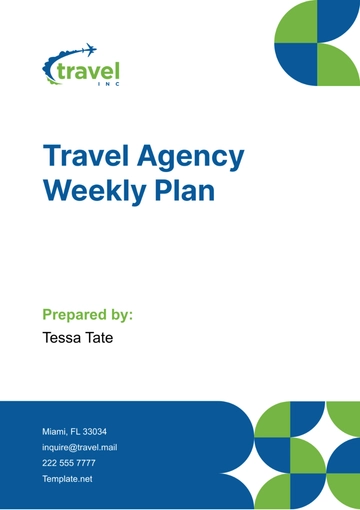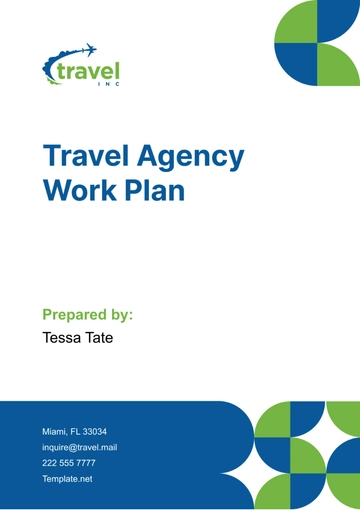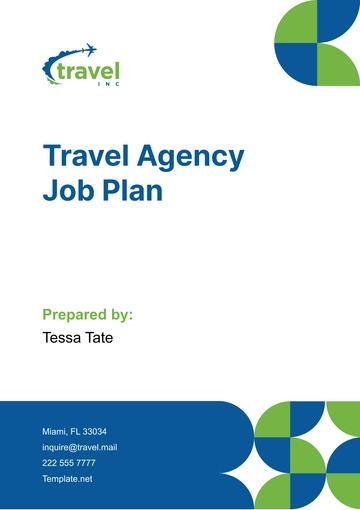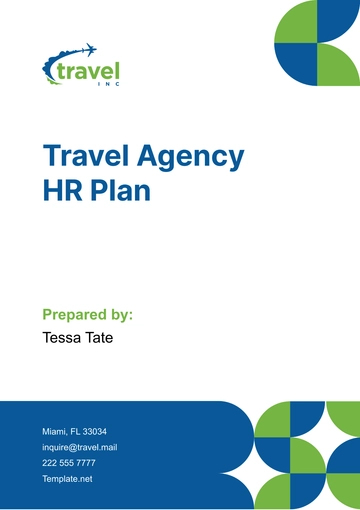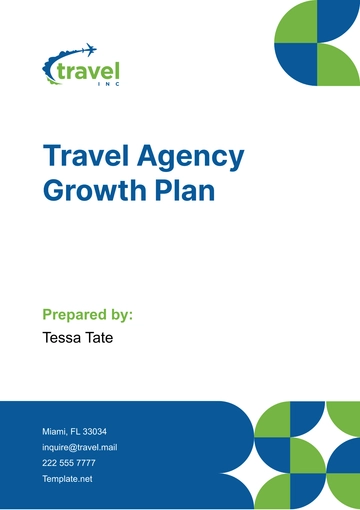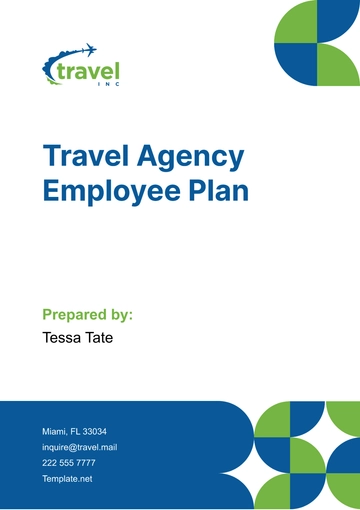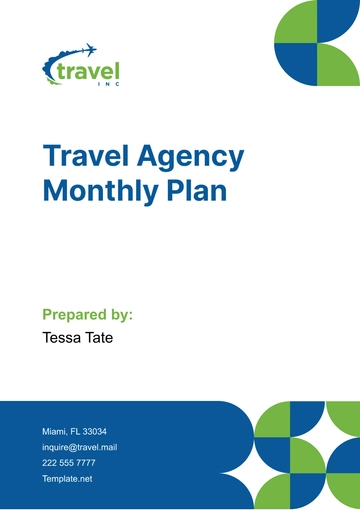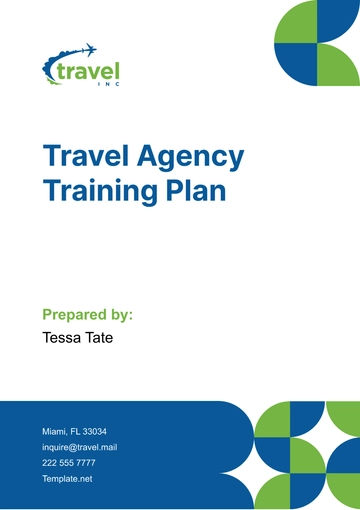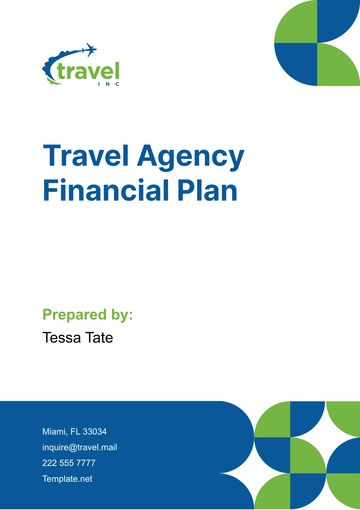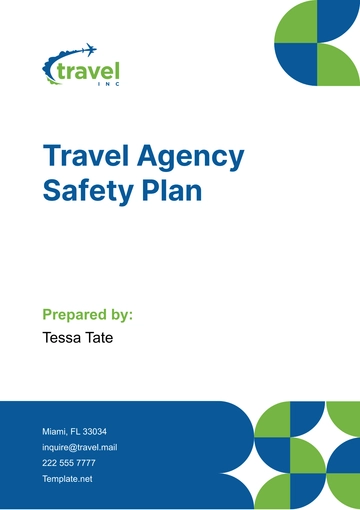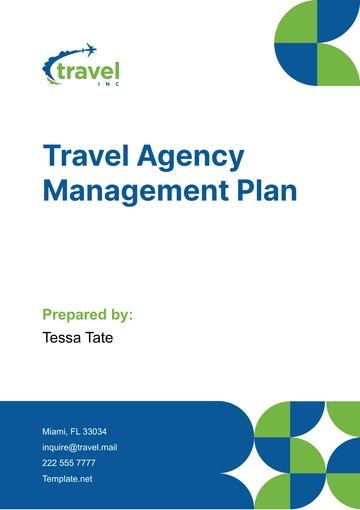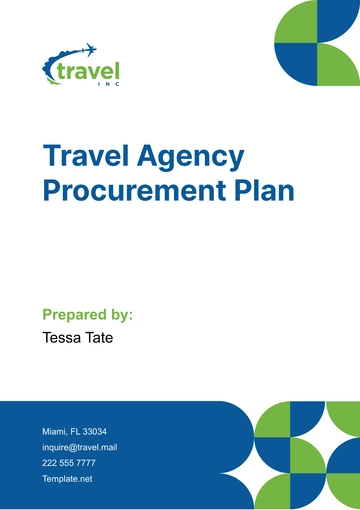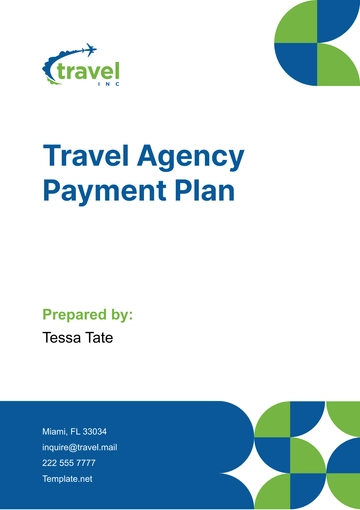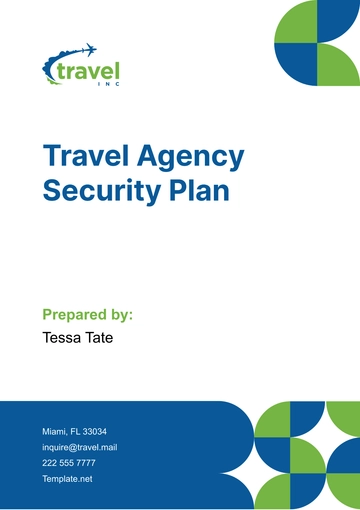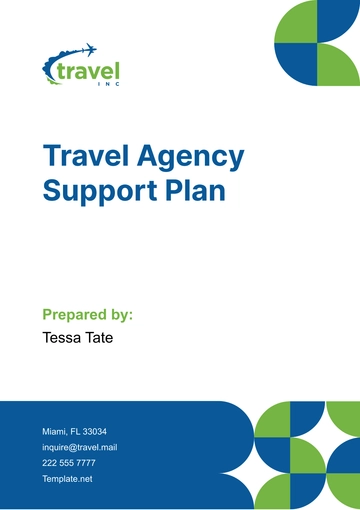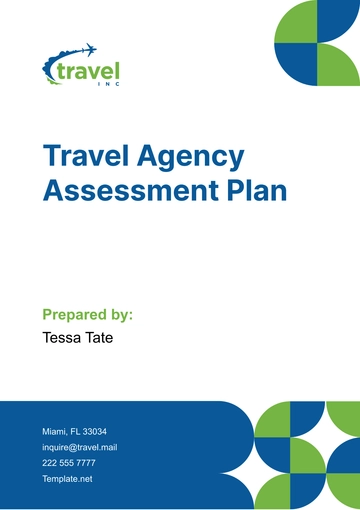Free Travel Agency Monthly Plan

I. Executive Summary
This Project Plan for [Your Company Name] is a comprehensive blueprint that outlines our strategic actions for enhancing market presence, boosting sales, and improving customer satisfaction. This document serves as a roadmap for our team, focusing on targeted marketing campaigns, partnerships, and customer engagement initiatives.
Our primary goal is to increase booking volumes by 15% and customer retention rates by 10%. To achieve this, we have allocated a total budget of $15,000, which will be judiciously used across various strategies to maximize return on investment. This budget will cover areas such as marketing, service development, sales tactics, and partnership development.
The plan is about creating memorable experiences for our customers and building lasting relationships. We believe that by focusing on customer-centric strategies, we can differentiate [Your Company Name] in the competitive travel industry and achieve sustainable growth.
II. Objective Setting
Objective setting is a critical step in our strategic planning process. It provides a clear direction for our team and helps us stay focused on our goals. Here are the detailed objectives for [Your Company Name]:
A. Primary Objectives
Our primary objectives for the next month are:
Increase overall bookings by 15%: We aim to boost our booking volumes by 15%. This will be achieved by enhancing our marketing efforts, offering attractive travel packages, and providing exceptional customer service. Our sales team will be trained to effectively communicate the value of our services to potential customers.
Enhance the engagement on our digital platforms by 20%: Our digital platforms are key channels for reaching our customers. We plan to increase engagement on these platforms by 20% through regular updates, interactive content, and prompt responses to customer inquiries. We believe that a more engaged audience will lead to higher conversion rates.
Launch two new exotic travel packages: We plan to introduce two new travel packages to our portfolio. These packages will be designed to cater to the evolving needs and preferences of our customers. We will conduct thorough market research to ensure that these packages are competitive and appealing to our target audience.
B. Secondary Objectives
In addition to our primary objectives, we have also set the following secondary objectives:
Improve customer service response times by 10%: We understand the importance of prompt and effective customer service in the travel industry. Therefore, we aim to improve our customer service response times by 10%. This will be achieved by providing additional training to our customer service team and implementing efficient customer service tools.
Increase social media followers by 15%: Social media is a powerful tool for reaching out to potential customers and engaging with existing ones. We plan to increase our social media followers by 15% through regular posts, engaging content, and interactive campaigns.
Boost website traffic by 20%: Our website is the primary platform where customers learn about our services and make bookings. We aim to boost our website traffic by 20% through search engine optimization, targeted ads, and partnerships with popular travel blogs and websites.
III. Target Audience Identification
Identifying the right target audience is a crucial step in our strategic planning process. It allows us to tailor our services and marketing efforts to the needs and preferences of our potential customers. The following table provides an overview of our target audience:
Audience Group | Age Range | Preferences |
|---|---|---|
Young Professionals | 25-40 | Unique and bespoke travel experiences |
Families | Varied | Safe vacation options |
Retirees | 60+ | Leisure travel |
A. Young Professionals
Young professionals aged 25-40 are a significant part of our target audience. This group is typically characterized by a desire for unique and bespoke travel experiences. They value adventure and exploration, and are often willing to pay a premium for personalized services. Our offerings for this group will focus on providing unique experiences that cannot be found elsewhere.
B. Families
Families form another important segment of our target audience. Safety is a top priority for this group when it comes to vacation options. They also value convenience and look for packages that take care of all aspects of the trip. Our family-friendly packages will be designed keeping these preferences in mind.
C. Retirees
Retirees, typically aged 60 and above, are interested in leisure travel. They usually have more flexibility in terms of travel dates and prefer relaxed itineraries. We will design our packages for this group with a focus on comfort and leisure, with ample time for rest and relaxation.
Learning about our target audience’s preferences helps us tailor our services and marketing strategies effectively. It allows us to create offerings that resonate with our potential customers, thereby increasing our conversion rates.
Moreover, having a clear understanding of our target audience also helps us in making strategic decisions about service development, marketing strategies, and sales tactics. It ensures that our efforts are focused and that we are able to provide the best possible service to our customers. By continuously monitoring and adapting to our target audience’s changing preferences, we can stay ahead in the competitive travel industry.
IV. Service Development
Service development is a key aspect of our plan. It involves creating new offerings and improving existing ones to meet the needs and preferences of our target audience. The following table outlines the new travel packages we plan to launch this month:
Package | Target Audience | Key Features |
|---|---|---|
Package 1: Eco-Luxury South American Trek | Young Professionals | Adventure, Eco-friendly, Luxury |
Package 2: Cultural Immersion Tour of Japan | Families, Retirees | Cultural experiences, Leisure activities |
A. Package 1: Eco-Luxury South American Trek
The “Eco-Luxury South American Trek” is designed for young professionals who seek adventure and care about the environment. This package combines thrilling outdoor activities with luxury accommodations that adhere to sustainable practices. It offers a unique opportunity for our customers to explore the stunning landscapes of South America while enjoying high-end services and contributing to environmental conservation.
B. Package 2: Cultural Immersion Tour of Japan
The “Cultural Immersion Tour of Japan” is aimed at families and retirees who are interested in experiencing the rich culture of Japan. This package includes visits to historical sites, participation in traditional Japanese activities, and leisure time to explore at their own pace. It provides a comprehensive experience of Japan, allowing our customers to immerse themselves in the local culture while enjoying a relaxing vacation.
Developing new services that cater to the specific needs and preferences of our target audience is crucial for our business. It allows us to differentiate ourselves in the competitive travel industry and provide unique value to our customers. These new packages are not just products; they are experiences that can create lasting memories for our customers.
Moreover, by continuously innovating our service offerings, we can stay ahead of market trends and meet the evolving demands of our customers. This not only helps us attract new customers but also retain existing ones, thereby contributing to our goal of increasing booking volumes and customer retention rates. We believe that with these new packages, [Your Company Name] will continue to provide exceptional travel experiences that exceed our customers’ expectations.
V. Marketing and Budget
The success of [Your Company Name] hinges not only on our ability to devise effective marketing strategies but also on our capacity to allocate our resources wisely. Our marketing and budget plan for the upcoming month is designed to maximize our reach while ensuring cost-effectiveness. The following chart and table provide the breakdown of our marketing strategies along with their associated costs:
Marketing Strategy | Description | Estimated Cost |
|---|---|---|
Email Marketing | Content-rich campaigns tailored to segmented customer groups | $2,000 |
Social Media Engagement | Regular posts, live sessions, and interactive content | $3,000 |
Influencer Collaboration | Collaborations with influencers who can reach our target demographics | $4,000 |
Targeted Ads | Targeted ads on platforms such as Google and Facebook | $5,000 |
Website Updates | Updating the website with attractive package details, clear pricing, and engaging visuals | $1,000 |
Total | $15,000 |
A. Email Marketing
Our email marketing strategy involves developing content-rich campaigns that are tailored to our segmented customer groups. With an estimated cost of $2,000, this strategy is designed to provide updates on our latest offerings, deliver personalized recommendations, and offer exclusive deals to our customers.
Content-rich Campaigns: Our email marketing strategy involves developing content-rich campaigns that are tailored to our segmented customer groups. These campaigns will not only provide updates on our latest offerings but also deliver personalized recommendations and exclusive offers. This approach aims to add value to our customers and keep [Your Company Name] at the forefront of their minds when planning their next trip.
Customer Segmentation: Customer segmentation is a key part of our email marketing strategy. By grouping our customers based on their preferences and past booking history, we can ensure that our emails are relevant and engaging. This targeted approach helps us to avoid sending generic emails and instead deliver content that our customers are genuinely interested in.
Performance Tracking: To ensure the effectiveness of our email campaigns, we will closely monitor key performance indicators such as open rates, click-through rates, and conversion rates. This data will provide valuable insights into what’s working and what’s not, allowing us to continually optimize our strategy.
A/B Testing: We will conduct A/B testing on our email campaigns to determine what type of content resonates best with our audience. This could involve testing different subject lines, email designs, or call-to-actions. The results of these tests will guide our future campaigns and help us to maximize engagement.
Automation: To ensure timely and consistent communication with our customers, we will leverage email automation tools. These tools will allow us to schedule emails in advance and send them out at optimal times, increasing the likelihood of our emails being opened and read.
B. Social Media Engagement
With a budget of $3,000, our social media engagement strategy includes regular posts, live sessions, and interactive content. This strategy aims to build a strong online community around our brand and engage with our audience in real-time.
Regular Posts: Regular posting is a fundamental part of our social media strategy. We will share engaging content that highlights our travel packages, shares travel tips, and encourages interaction with our followers. Regular posts will keep our brand visible in our followers’ social media feeds and help to build a strong online community around our brand.
Live Sessions: We plan to host live sessions on our social media platforms. These could include Q&As, virtual tours, or guest appearances from travel influencers. Live sessions are a great way to engage with our audience in real-time and provide them with unique and valuable content.
Interactive Content: We will create interactive content such as quizzes, polls, and contests to engage our audience and increase our reach. Interactive content not only entertains our followers but also encourages them to interact with our posts and share them with their own followers.
Community Building: We will focus on building a community on our social media platforms. This involves encouraging our followers to interact with our posts and with each other, creating a sense of community and belonging. A strong online community can lead to increased brand loyalty and word-of-mouth referrals.
C. Influencer Collaboration
Influencer collaboration is a powerful marketing strategy that allows us to reach a wider audience. With a budget of $4,000, we plan to collaborate with influencers who have a strong following among our target demographics.
Identifying Influencers: As part of our influencer marketing strategy, we will identify influencers who have a strong following among our target demographics. These influencers will have established trust and credibility with their followers, making them effective partners for promoting our brand.
Collaboration: Once we have identified suitable influencers, we will reach out to them for collaboration opportunities. This could involve them experiencing our travel packages and sharing their experiences with their followers, or it could involve co-creating content for our social media platforms.
Content Creation: We will work closely with our influencer partners to create engaging content that showcases the unique features of our travel packages. This content will be shared on the influencer’s social media platforms, allowing us to reach a wider audience.
Performance Tracking: We will track the performance of our influencer collaborations using key metrics such as reach, engagement, and conversions. This data will help us to assess the effectiveness of our influencer marketing strategy and make necessary adjustments.
D. Targeted Ads
Targeted ads are an effective way to reach our target audience on platforms where they are most active. With an estimated cost of $5,000, we plan to launch targeted ads on platforms such as Google and Facebook.
Platform Selection: We will launch targeted ads on platforms where our target audience is most active. This includes platforms such as Google and Facebook. By choosing the right platforms, we can ensure that our ads are seen by the right people.
Ad Creation: We will create engaging ad content that highlights the unique features of our travel packages. Our ads will be designed to catch the viewer’s attention and encourage them to learn more about our offerings.
Targeting: We will use advanced targeting options to ensure our ads reach our target audience. This involves defining our audience based on factors such as age, location, interests, and online behavior.
Performance Tracking: We will closely monitor the performance of our ads using key metrics such as impressions, clicks, and conversions. This data will provide valuable insights into the effectiveness of our ads and help us to optimize our ad spend.
E. Website Updates
Updating our website is crucial for providing our customers with the latest information about our travel packages. With a budget of $1,000, we plan to update our website with attractive package details, clear pricing, and engaging visuals.
Package Details: We will update our website with detailed information about our travel packages. This includes descriptions of the packages, itineraries, pricing information, and high-quality images. By providing comprehensive information, we can help our customers make informed decisions.
Clear Pricing: We will provide clear pricing information on our website. This involves breaking down the costs of our packages and explaining what is included in the price. Clear pricing helps to build trust with our customers and eliminates any potential confusion.
Engaging Visuals: We will use engaging visuals on our website to showcase our travel packages. High-quality images and videos can help to bring our packages to life and give our customers a taste of what they can expect.
User Experience: We will focus on improving the user experience on our website. This involves making our website easy to navigate, ensuring that information is easy to find, and making the booking process as simple as possible.
SEO: We will optimize our website for search engines, helping us attract organic traffic. This involves using relevant keywords in our content, optimizing our website’s speed, and ensuring that our website is mobile-friendly.
By allocating our resources wisely, we aim to maximize the effectiveness of our marketing strategies while ensuring cost-effectiveness. We believe that a well-planned budget is key to achieving our marketing objectives and driving the growth of [Your Company Name].
VI. Sales Tactics
Sales tactics are the specific actions we take to persuade potential customers to book our travel packages. They play a crucial role in converting our marketing efforts into actual sales. Here’s a more detailed look at our sales tactics for the upcoming month:
A. Sales Team Training
Up-selling Techniques: We will train our sales team on up-selling techniques. This involves persuading customers to purchase a more expensive package or add-ons to enhance their travel experience. By effectively up-selling, we can increase our revenue without acquiring new customers.
Cross-selling Techniques: In addition to up-selling, we will also train our sales team on cross-selling techniques. This involves recommending additional relevant services to customers. For example, if a customer is booking a travel package, we might recommend travel insurance or airport transfer services.
Product Knowledge: We will ensure that our sales team has in-depth knowledge of all our travel packages. This will enable them to answer customer queries accurately and confidently, thereby building trust with our customers.
Communication Skills: We will provide training on effective communication skills. This includes active listening, empathy, and clear communication. These skills are crucial for understanding customer needs and providing excellent customer service.
Sales Tools: We will train our sales team on how to use various sales tools. These tools can help our team manage customer relationships, track sales performance, and automate routine tasks.
B. Early Bird Discounts
Discount Strategy: We will offer early bird discounts on our new travel packages. This strategy encourages customers to make their bookings in advance, which helps us manage our resources more effectively.
Promotion: We will promote our early bird discounts through various channels, including email marketing, social media, and our website. This will ensure that our offer reaches a wide audience.
Terms and Conditions: We will clearly communicate the terms and conditions of our early bird discounts. This includes the discount amount, the booking period, and any other conditions. Clear communication helps to avoid misunderstandings and build trust with our customers.
Performance Tracking: We will track the performance of our early bird discounts. This includes the number of bookings made, the revenue generated, and the impact on customer satisfaction. This data will help us optimize our discount strategy.
C. Referral Program
Program Design: We will implement a referral program that incentivizes word-of-mouth marketing. This involves offering rewards to customers who refer their friends and family to our travel agency.
Promotion: We will promote our referral program through various channels, including email marketing, social media, and our website. This will ensure that our customers are aware of the program and understand how it works.
Reward Fulfillment: We will ensure that rewards are fulfilled promptly and accurately. This helps to build trust with our customers and encourages them to make more referrals.
Program Evaluation: We will regularly evaluate the effectiveness of our referral program. This involves tracking the number of referrals made, the number of new customers acquired through referrals, and the impact on customer loyalty. This data will help us to continuously improve our referral program and maximize its benefits.
D. Product Bundling
Bundling Strategy: We will bundle products for special deals, such as combining flights, hotel bookings, and tour packages into a single offering. This not only provides convenience to our customers but also increases the perceived value of our offerings.
Promotion: We will promote our bundled deals through various channels, including email marketing, social media, and our website. This will ensure that our customers are aware of these deals and can take advantage of them.
Pricing: We will carefully price our bundled deals to ensure they are competitive and attractive to our customers. This involves considering the individual prices of the bundled products and offering a discount for the bundle.
Performance Tracking: We will track the performance of our bundled deals. This includes the number of deals sold, the revenue generated, and the impact on customer satisfaction. This data will help us optimize our bundling strategy.
E. Personalized Communication
Customer Segmentation: We will segment our customers based on their preferences and past booking history. This allows us to personalize our communication and ensure that our messages are relevant and engaging.
Personalized Offers: We will send personalized offers to our customers. This involves recommending travel packages that match their preferences and offering exclusive deals that are tailored to their needs.
Customer Relationship Management (CRM) System: We will use a CRM system to manage our customer relationships and personalize our communication. The CRM system will store information about our customers’ preferences, past bookings, and interactions with our agency, enabling us to provide a personalized service.
Performance Tracking: We will track the effectiveness of our personalized communication. This includes monitoring open rates, click-through rates, and conversion rates for our personalized emails and messages. This data will provide valuable insights into how well our personalized communication is resonating with our customers and help us to continuously improve our communication strategy.
VII. Partnership Development
Partnership development is a strategic approach that we at [Your Company Name] believe can enhance our service offerings and expand our market reach. By collaborating with other businesses that align with our goals and values, we can provide more comprehensive and attractive travel packages to our customers. Here's an in-depth overview of our strategies for developing partnerships in the next month:
A. Local Tour Operators
Partnership Identification: We aim to collaborate with local tour operators in popular destinations. These operators have in-depth knowledge of the local area and can provide unique experiences that are not available through larger tour companies. We will identify potential partners based on the quality of their services, their reputation, and their alignment with our brand values.
Partnership Negotiation: Once potential partners have been identified, we will negotiate the terms of the partnership. This includes discussing how we can work together to create unique travel packages, how profits will be shared, and how the partnership will be promoted.
Partnership Implementation: After the terms of the partnership have been agreed upon, we will work closely with our new partners to integrate their services into our travel packages. This includes updating our website and marketing materials to highlight the new offerings.
Partnership Evaluation: We will regularly evaluate the success of our partnerships. This involves tracking the sales of travel packages that include our partners’ services and gathering customer feedback on their experiences.
B. Airline Companies
Partnership Identification: We will seek partnerships with airline companies that can offer special fares to our customers. By partnering with airlines, we can provide more cost-effective travel packages, making our offerings more attractive to price-sensitive customers.
Partnership Negotiation: We will negotiate with potential airline partners to secure the best deals for our customers. This includes discussing volume discounts, flexible booking options, and co-marketing opportunities.
Partnership Implementation: Once a partnership agreement has been reached, we will update our travel packages to include the special fares. We will also promote the partnership through our marketing channels to raise awareness among our customers.
Partnership Evaluation: We will track the impact of our airline partnerships on our sales and customer satisfaction. This data will help us to assess the effectiveness of the partnership and make necessary adjustments.
C. Eco-friendly Hotels
Partnership Identification: We aim to collaborate with eco-friendly hotels as part of our commitment to sustainable tourism. These hotels implement practices that minimize their impact on the environment, aligning with the values of our eco-conscious customers.
Partnership Negotiation: We will negotiate with potential hotel partners to secure the best rates for our customers. We will also discuss how we can work together to promote sustainable tourism.
Partnership Implementation: After the terms of the partnership have been agreed upon, we will incorporate the eco-friendly hotels into our travel packages. We will highlight the hotels’ eco-friendly practices in our marketing materials to attract eco-conscious travelers.
Partnership Evaluation: We will evaluate the success of our partnerships with eco-friendly hotels by tracking the sales of travel packages that include their services and gathering customer feedback.
VIII. Customer Feedback System
A robust customer feedback system is integral to our continuous improvement at [Your Company Name]. It provides us with valuable insights directly from our customers, allowing us to understand their needs, preferences, and experiences better. Here's an in-depth view of our customer feedback system for the upcoming month.:
A. Post-trip Survey System
Survey Design: This month, we will implement a new post-trip survey system to gather detailed customer feedback. The survey will be designed to cover various aspects of the customer’s experience, including the booking process, the travel package, the customer service, and the overall satisfaction.
Survey Distribution: The post-trip survey will be sent to customers after they have completed their trip. This ensures that the experience is still fresh in their minds, leading to more accurate and detailed feedback.
Response Collection: We will collect the survey responses and store them in a secure database. We will ensure that the response collection process is easy and convenient for our customers, encouraging higher response rates.
Data Analysis: We will analyze the survey data to identify trends, patterns, and areas for improvement. This involves using statistical analysis techniques and data visualization tools.
Action Planning: Based on the survey results, we will develop action plans to address the identified areas for improvement. This could involve making changes to our travel packages, improving our customer service, or enhancing our marketing strategies.
B. Direct Customer Feedback
In addition to the post-trip survey, we will also collect direct feedback from our customers. This includes feedback received through our website, social media platforms, and customer service channels.
Feedback Collection: We will provide multiple channels for our customers to share their feedback. This includes a feedback form on our website, direct messages on our social media platforms, and email.
Feedback Review: We will regularly review the direct feedback received from our customers. This involves reading through the feedback, categorizing it based on the topic, and identifying common issues or suggestions.
Response: We will respond to our customers’ feedback in a timely and professional manner. This involves thanking them for their feedback, addressing their concerns, and informing them of any actions taken as a result of their feedback.
Action Planning: Similar to the post-trip survey, we will develop action plans based on the direct feedback received from our customers. This ensures that we are continuously improving our services based on our customers’ needs and preferences.
IX. Performance Evaluation
Performance evaluation allows us to measure the effectiveness of our strategies and make necessary adjustments to ensure we are on track to achieve our objectives. Here is our performance evaluation process for the upcoming month:
A. Sales Data Tracking
Data Collection: We will track sales data, including the number of bookings, revenue generated, and average transaction value. This data will be collected through our booking system and stored in a secure database.
Data Analysis: We will analyze the sales data to identify trends, patterns, and areas for improvement. This involves comparing the actual sales performance against our objectives and identifying any gaps.
Performance Reporting: We will create performance reports that provide a clear and concise overview of our sales performance. These reports will be shared with our team and used in our review meetings.
Action Planning: Based on the sales data analysis, we will develop action plans to improve our sales performance. This could involve adjusting our marketing strategies, enhancing our travel packages, or providing additional training to our sales team.
Continuous Monitoring: We will continuously monitor our sales data to ensure we are on track to achieve our objectives. This involves regularly updating our performance reports and making real-time adjustments to our strategies as needed.
B. Customer Feedback
Feedback Collection: We will collect customer feedback through our post-trip survey system and direct feedback channels. This feedback provides valuable insights into our customers’ experiences and satisfaction levels.
Feedback Analysis: We will analyze the customer feedback to identify common themes, issues, and suggestions. This involves categorizing the feedback based on the topic and calculating satisfaction scores.
Performance Reporting: We will include customer feedback in our performance reports. This provides a more holistic view of our performance, combining quantitative sales data with qualitative customer feedback.
Action Planning: Based on the customer feedback analysis, we will develop action plans to improve our customer satisfaction. This could involve making changes to our travel packages, improving our customer service, or enhancing our communication strategies.
Continuous Monitoring: We will continuously monitor our customer feedback to ensure we are meeting our customers’ expectations and continuously improving based on their feedback.
C. Digital Engagement Metrics
Metric Selection: We will track digital engagement metrics such as website traffic, social media engagement, and email open rates. These metrics provide insights into the effectiveness of our digital marketing strategies.
Data Collection: We will collect the digital engagement data through various tools such as Google Analytics, social media analytics, and email marketing analytics.
Data Analysis: We will analyze the digital engagement data to identify trends, patterns, and areas for improvement. This involves comparing the actual performance against our objectives and identifying any gaps.
Performance Reporting: We will include digital engagement metrics in our performance reports. This provides a more comprehensive view of our performance, combining sales data, customer feedback, and digital engagement metrics.
Action Planning: Based on the digital engagement data analysis, we will develop action plans to improve our digital marketing performance. This could involve adjusting our content strategy, enhancing our website, or optimizing our email campaigns.
X. Conclusion
This Project Plan for [Your Company Name] is designed to aggressively push forward in gaining market share, improving customer experiences, and increasing profitability. By adhering to the outlined strategic actions and continuously monitoring our progress, we aim to achieve significant growth and customer satisfaction in the competitive travel industry.
Overall, we believe that this plan provides a clear direction for [Your Company Name] and sets the stage for a successful future. We are committed to implementing these strategies with diligence and adaptability, ready to make necessary adjustments based on market trends and customer feedback. With a customer-first approach and a commitment to continuous improvement, we are confident that [Your Company Name] will continue to thrive and provide exceptional travel experiences for our customers.
- 100% Customizable, free editor
- Access 1 Million+ Templates, photo’s & graphics
- Download or share as a template
- Click and replace photos, graphics, text, backgrounds
- Resize, crop, AI write & more
- Access advanced editor
Stay organized and focused on goals with our customizable Travel Agency Monthly Plan Template! This editable and strategic document from Template.net provides a structured format for outlining monthly targets to be accomplished within your agency. Use our AI Editor Tool to customize the monthly plan with specific tasks and deadlines!
You may also like
- Finance Plan
- Construction Plan
- Sales Plan
- Development Plan
- Career Plan
- Budget Plan
- HR Plan
- Education Plan
- Transition Plan
- Work Plan
- Training Plan
- Communication Plan
- Operation Plan
- Health And Safety Plan
- Strategy Plan
- Professional Development Plan
- Advertising Plan
- Risk Management Plan
- Restaurant Plan
- School Plan
- Nursing Home Patient Care Plan
- Nursing Care Plan
- Plan Event
- Startup Plan
- Social Media Plan
- Staffing Plan
- Annual Plan
- Content Plan
- Payment Plan
- Implementation Plan
- Hotel Plan
- Workout Plan
- Accounting Plan
- Campaign Plan
- Essay Plan
- 30 60 90 Day Plan
- Research Plan
- Recruitment Plan
- 90 Day Plan
- Quarterly Plan
- Emergency Plan
- 5 Year Plan
- Gym Plan
- Personal Plan
- IT and Software Plan
- Treatment Plan
- Real Estate Plan
- Law Firm Plan
- Healthcare Plan
- Improvement Plan
- Media Plan
- 5 Year Business Plan
- Learning Plan
- Marketing Campaign Plan
- Travel Agency Plan
- Cleaning Services Plan
- Interior Design Plan
- Performance Plan
- PR Plan
- Birth Plan
- Life Plan
- SEO Plan
- Disaster Recovery Plan
- Continuity Plan
- Launch Plan
- Legal Plan
- Behavior Plan
- Performance Improvement Plan
- Salon Plan
- Security Plan
- Security Management Plan
- Employee Development Plan
- Quality Plan
- Service Improvement Plan
- Growth Plan
- Incident Response Plan
- Basketball Plan
- Emergency Action Plan
- Product Launch Plan
- Spa Plan
- Employee Training Plan
- Data Analysis Plan
- Employee Action Plan
- Territory Plan
- Audit Plan
- Classroom Plan
- Activity Plan
- Parenting Plan
- Care Plan
- Project Execution Plan
- Exercise Plan
- Internship Plan
- Software Development Plan
- Continuous Improvement Plan
- Leave Plan
- 90 Day Sales Plan
- Advertising Agency Plan
- Employee Transition Plan
- Smart Action Plan
- Workplace Safety Plan
- Behavior Change Plan
- Contingency Plan
- Continuity of Operations Plan
- Health Plan
- Quality Control Plan
- Self Plan
- Sports Development Plan
- Change Management Plan
- Ecommerce Plan
- Personal Financial Plan
- Process Improvement Plan
- 30-60-90 Day Sales Plan
- Crisis Management Plan
- Engagement Plan
- Execution Plan
- Pandemic Plan
- Quality Assurance Plan
- Service Continuity Plan
- Agile Project Plan
- Fundraising Plan
- Job Transition Plan
- Asset Maintenance Plan
- Maintenance Plan
- Software Test Plan
- Staff Training and Development Plan
- 3 Year Plan
- Brand Activation Plan
- Release Plan
- Resource Plan
- Risk Mitigation Plan
- Teacher Plan
- 30 60 90 Day Plan for New Manager
- Food Safety Plan
- Food Truck Plan
- Hiring Plan
- Quality Management Plan
- Wellness Plan
- Behavior Intervention Plan
- Bonus Plan
- Investment Plan
- Maternity Leave Plan
- Pandemic Response Plan
- Succession Planning
- Coaching Plan
- Configuration Management Plan
- Remote Work Plan
- Self Care Plan
- Teaching Plan
- 100-Day Plan
- HACCP Plan
- Student Plan
- Sustainability Plan
- 30 60 90 Day Plan for Interview
- Access Plan
- Site Specific Safety Plan
